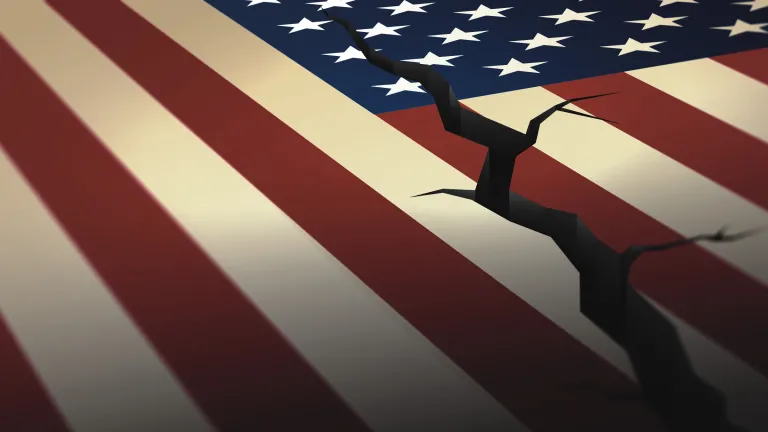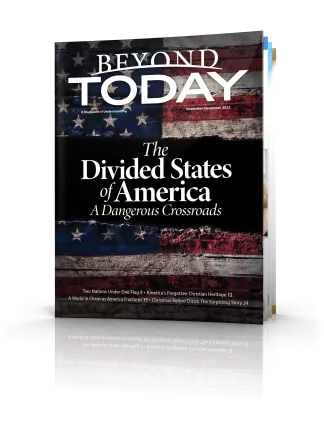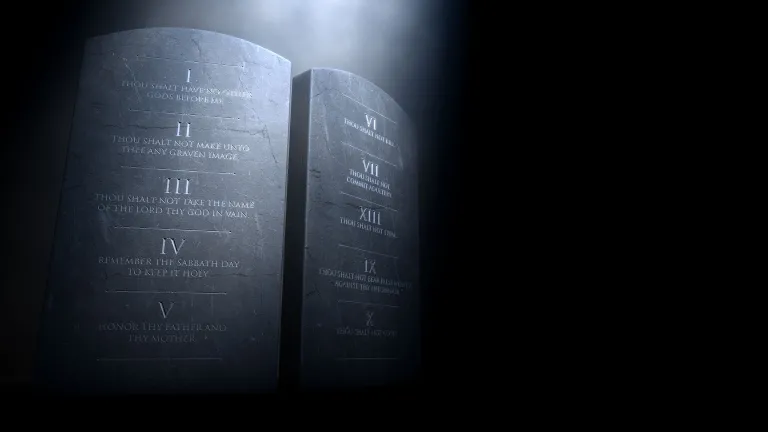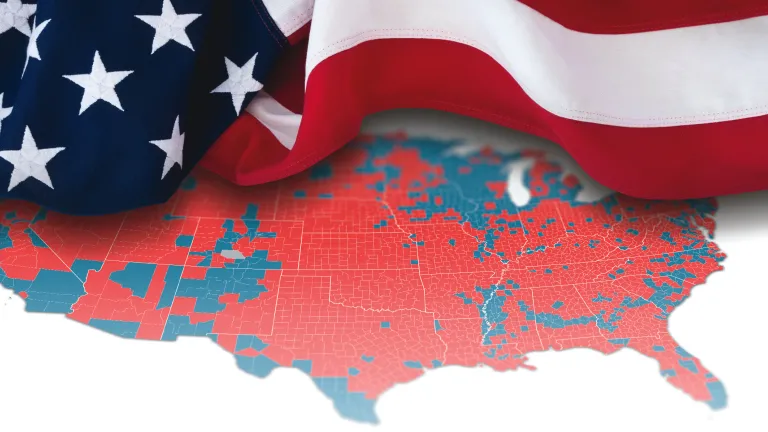The Divided States of America: A Dangerous Crossroads

The nation’s division is so obvious that growing numbers of people expect violence, bloodshed and perhaps even another civil war. What’s behind this, and what does it mean for you?
My dear mother was a child of the American South. Decades ago, on visits to Alabama to see relatives, we always stopped at the site of the Battle of Shiloh, one of the bloodiest conflicts of the American Civil War. “Those poor boys,” she would mourn, “bleeding to death in this pond.” She would blame “those Yankees” for being where they shouldn’t be. She remembered times when the cultural divide split the nation into two warring halves. She wanted me to understand and never forget.
I think about her stories when today I hear statements that America is again deeply divided in ways that could lead to another civil war. Indeed, some feel that we are already fighting that war along political, cultural and social fronts and that, in time, without healing, we could very well see division occur with states opting out of the union.
Polls indicate that more than two thirds of Americans perceive strong threats to the continuing existence of American democracy as we currently know it. They feel that a civil war could erupt and that only a strong leader could either prevent or lead the country out of the crisis.
Where might “irreconcilable differences” lead?
Partisan politics highlight this divide. A 2022 Pew Research poll found a majority in both parties view members of the other party as “more immoral, dishonest, lazy, unintelligent, and close-minded than other Americans.” Curiously, 40 percent of Democrats and 43 percent of Republicans belong to their party because “they oppose the other party’s values” and not because they stand for what their party represents.
Political scientists refer to this level of polarization as “negative partisanship,” in which political factions draw together more out of hatred of the other side than a common sense of purpose. This negative partisanship explains more than a political divide in the nation today.
A functional political process should lead to resolution of conflicting ideas. In the best of times there’s a better chance of accomplishing this. When I say “best of times,” I’m referring to a period of 60 or more years ago. Partisan politics in America has always been raucous, but at the end of the vote the differing factions sought to reach across the aisle and make a clear path forward for the good of the country.
Yet that was when there were clearly shared values and a commitment to form a common community. That was also a time when there was a commitment to the idea of America as laid down in the nation’s founding documents.
But that has changed. The presidential election of 2000 appears to have marked the emergence of irreconcilable differences in the body politic, beginning the slide to our place today. That election had to be decided by the Supreme Court, ending in the election of George W. Bush. It seems that from that rancorous election the country entered an era of political acrimony that has only accelerated to the present crisis.
Polling data from the University of Chicago Institute of Politics show sobering results: “About three-quarters (73 percent) of voters who identify themselves as Republican agree that ‘Democrats are generally bullies who want to impose their political beliefs on those who disagree.’ An almost identical percentage of Democrats (74 percent) express that view of Republicans.” A similarly lopsided majority of each party holds that members of the other are “generally untruthful and are pushing disinformation.”
“I’m ready for them”
The same poll revealed that “more than one in four Americans are so alienated from their government” that they believe it may “soon be necessary to take up arms” against it.” When a large and growing number of Americans feel their government is corrupt and rigged against them, it’s hard to see a way back from the abyss. There is a growing feeling of incompatibility. And in some regions of the country, the talk is that the only answer may be secession.
Anger over public policy has caused a fourfold increase in people who feel armed force is justified to advance political interests. This sentiment is held by nearly equal percentages of both Republicans and Democrats—roughly a third of each.
Sales of guns and ammunition have skyrocketed in recent years, an alarming rise considering there were already more guns in America than people. With scenes of rioting in cities, whole neighborhoods taken over by radicals and even police precincts being abandoned by law enforcement, people fear there will be no one to answer their call for help when, not if, rioters advance on their neighborhoods.
When you watch televised accounts of such events, like that of a suburban couple in St. Louis, Missouri, in 2020 defending their home from an invading pack of protestors, you begin to get the feeling the nation is turning into an armed camp. While sitting at dinner in the home of a close relative, he pointed out to me his self-defense plan, which included a brick and stone barricade at the edge of his patio pool angled perfectly to allow him to defend the half-mile-long road approaching his rural home. “I’m ready for them when they come,” he told me.
Abortion: a great polarizer
Arguably the most polarizing issue of the last half-century has been abortion. Since the 1973 Supreme Court decision legalizing abortion in all 50 states, we have witnessed tens of millions of babies torn from the wombs of their mothers. While the prevalence of abortions grew, so too did a growing opposition led by churches and citizens with a conscience.
A person’s stance on abortion determined whether he or she could be elected to political office or appointed to the Supreme Court. In June 2022 the Supreme Court, ruling in a new case, announced its decision to overturn the Roe v. Wade decision and turn the issue over to individual states. It was a welcome event for those who value the sanctity of human life. But the divide only grew wider.
The impact of the reversal is still taking shape. Abortion will not disappear. It is now up to the states to legislate and regulate. Some have and will pass anti-abortion laws while others have and will pass pro-abortion laws.
Corporations in states with stricter limits on abortion will include as part of employee health-care packages benefits to travel to a pro-abortion state to obtain an abortion as a “health benefit.” Some companies have ended maternity leave and maternity benefits, replacing them with paid abortions. It’s clear where these corporations’ interests lie.
We have entered uncharted territory with this decision. Along with
all the other cultural upheavals, we seem to have entered a dark time. The world order we have known is showing its rot. It could soon shatter, and the condition of America will determine the future.
Will we see armed conflict?
Are we at a moment where armed insurrection could erupt in America? A survey of headlines and events in recent years leads any observer to answer yes, it is possible that some kind of civil war could erupt. The heated political environment could easily turn violent—especially when some are deliberately trying to escalate matters. Apparent weaponization of government agencies against political opponents exacerbates fears and the will to resist what is increasingly viewed as illegitimate force.
Count in the increase in overall crime, mass shootings, murders, carjackings, civil unrest in major cities and diminishing police protection, and we have a picture of a nation in severe distress, with many believing they must take the protection of themselves and others into their own hands. America seems to be on a volcanic fault line waiting for something to explode.
But the question is, will we see armed conflict on the scale of the great Civil War of the 1800s where an actual secession of southern states led to armed conflict and the deaths of more than 600,000 Americans? I don’t think so—at least not in that way. The conflict will likely manifest itself differently. Let’s consider what has already happened. That may give us clues to the future.
New mandates leading to chaos?
I have written in these pages that what we’ve seen in the past three years have been dress rehearsals for bigger events to come. I wonder if we’ve seen what a breakdown in order in America might look like. The past may just be a prelude to the future.
First, we saw an unprecedented shutdown of American society beginning in March 2020. Airports shut down as passenger flights ended. Schools and businesses closed. The lights went out in the great entertainment areas like Times Square in New York City. Professional sports venues were shuttered.
This happened around the world in response to the Covid pandemic. Beyond the shutdown was the fact that people so quickly, without discussion or debate, went along with the mandates, assuming it to be for the public good. Yet hindsight has called into question the radical steps taken by governments.
What if a future crisis, another pandemic or civil crisis, led to a shutdown? Would people across America submit to this again? What if some regions (such as “blue states”) went along with a federal government mandate while other regions (so-called “red states”) refused?
This would highlight a stark divide within the nation. How would the central government react? Would federal troops be called out to enforce its mandates? Some regions would not take kindly to the presence of armed soldiers enforcing regulations opposed by the majority of people there. Resistance, both passive and likely armed, would be the response. There could be bloodshed.
American presidential elections in recent years have seen narrow margins of victory. What if a duly elected leader were attacked or assassinated by someone aligned with the opposite faction? How would that leader’s supporters react? Could it incite massive civil unrest or even retaliatory killings?
Imagine the chilling effect that would have on the general public. Fear and suspicion would set in. We might not see armed insurrection; rather we would see pockets of resistance spring up. Some cities or regions in rural areas might become armed camps or might declare themselves “seceded from the union.”
In 2020 we saw a defined urban section of Seattle cordoned off for several weeks as people declared it a separate zone from the city and would not allow in police, fire or emergency personnel. Law enforcement, handcuffed by a progressive city government, stood by helpless to intervene. What if this happened on a larger scale across the nation in response to political disagreement?
As in the days of Noah
A massive natural disaster such as a hurricane or earthquake could spark unrest along with imposition of emergency mandates creating cascading effects. In 2005 Hurricane Katrina hit southern Louisiana bringing massive destruction to New Orleans and surrounding regions.
By itself the hurricane wreaked enormous devastation. But government reaction at the city, state and federal level compounded the problem. It took years to recover. While cries of incompetence, neglect and even racism rose from many quarters, peace and stability were restored, and people pulled together to rebuild. It was a different time. Would it be the same today?
What if another such natural disaster struck and, given the fragile condition of the nation today, the social fabric of a region was ripped apart? What would happen in other cities? Would there be reactions triggered by hate and latent unrest? I think about the death of George Floyd in May 2020 in Minneapolis and what that incident sparked across the country. A ripple effect tends to develop in these cases. It happened in 1968 with the assassination of Martin Luther King when riots erupted across the nation. Again, we learn from the past and can project into the future.
Most people would try to go about living a normal life. Note I said “try.” That is our present situation. Most Americans are trying to go about living a normal life. That’s normal. The problem is the norms are changing, perhaps irrevocably.
I heard a pertinent quote recently: “Every norm of the present life is being attacked.” That’s true. Most see it. Many are unnerved. We are in a time of civil disturbance but are continuing on, trying to live a normal life.
Jesus said this would be the case: “But as the days of Noah were, so also will the coming of the Son of Man be. For as in the days before the flood, they were eating and drinking, marrying and giving in marriage, until the day that Noah entered the ark, and did not know until the flood came and took them all away, so also will the coming of the Son of Man be” (Matthew 24:37-39).
As in Noah’s day, the norms have changed, people are divided and judgment is coming.
Dishonoring the natural order of life
The overturn of Roe v. Wade’s license to murder unborn babies was a welcome and needed decision by the Supreme Court. But the rot remains. Abortion is still legal in the majority of states. The culture was changed by a half-century of a cultural holocaust. While many jurists praise the Supreme Court for returning to the states, and to the people through their elected representatives, the prerogative to make laws governing the social compact, the horror of the 49-year legalization of infanticide has warped the moral compass of a people.
The 2015 Supreme Court decision on same-sex marriage, Obergefell v. Hodges, has piggybacked on the moral decline and divide, creating an America where those who hold the line for the biblical definition of marriage and human life are considered outcasts. Where Roe legislated on the sanctity of human life, Obergefell undermined the moral basis of society.
While its legal premise is nonexistent, it is the spear thrust at the heart of a sane, stable and natural society to devastating effect. Healthy civilizations do not treat the biblical definition of marriage and family as a “choice.” Stable marriages balance a culture, honor God and provide a nurturing environment for bringing up the next generation of children. Same-sex marriages dishonor the natural order of life. They violate the eternal spiritual law of God. They are a death sentence for mankind, another manifestation of cultural suicide.
Those who identify as Christian must accept their part in the decline of the biblical marriage and family. Divorce rates among those who claim to be Christian have for many decades been high. Cohabitation without the commitment of marriage has also been high among this group. Long before same-sex marriage became legal, the institution of marriage had already been undermined by those who should have been stalwart examples.
Abortion and same-sex marriage, and now the growing influence of the LGBTQ+ movement, have hollowed out the moral center of the United States and other Western nations. Political polarization has deepened in recent decades. Government overspending has worsened the economy, bringing back rates of inflation unseen for 40 years. Confidence in the federal government is at historic lows.
All these and many other factors have led to the great division we see in America today. At its core it is a division over the cultural foundation and direction of the nation. Some hold to the principles and values on which the nation was founded, even as others deny and defy those same principles and values (see “America’s Forgotten Christian Heritage” beginning on page 12).
America’s divide has created a question among the nations as to whether it can be relied on as an ally to guarantee stability. The result is the emboldening of other nations like China and Russia to assert their national agenda. Russia has invaded Ukraine. The world holds its breath, expecting China to take over Taiwan, fulfilling its long-held desire to reunite the island state with the mainland.
The question hangs over the world: Can a divided America be relied on? This is what is at stake with the current internal problems facing the nation.
Is America committing suicide?
Some say the only country powerful enough to destroy the United States is America itself. Abraham Lincoln thought the same. In an 1838 speech he said: “At what point shall we expect the approach of danger? By what means shall we fortify against it? Shall we expect some transatlantic military giant to step the Ocean and crush us at a blow? Never! . . . At what point then is the approach of danger to be expected? I answer, if it ever reach us, it must spring up amongst us. It cannot come from abroad. If destruction be our lot, we must ourselves be its author and finisher. As a nation of freemen, we must live through all time, or die by suicide” (Lyceum Address, emphasis added).
As divided as America may be, it is still the strongest nation in the world by any measure. All things being as they are, the nation can, and might, continue in this role for a good while longer. The Roman Empire lasted hundreds of years while torn by internal division. However, that was the ancient world, and many factors are different today. And yes, Lincoln guided the nation through the Civil War and the republic survived. The nation went on to become the single greatest nation of all history. Americans today are the inheritors of all that story.
But there is a difference between Rome and America today—and between America at the time of Lincoln and America today. The difference is in the role God has placed America in at this time for the greater spiritual purpose He is working among the nations. The United States will maintain that role only as long as God allows. (For more information on America’s divine purpose, request or download our free study guide The United States and Britain in Bible Prophecy.)
Much has been written about how America was founded by men who believed in divine providence and the God of the Bible. The Pilgrims landed on these shores in search of religious freedom, and many of them looked at the land before them as a type of the Promised Land into which God brought the ancient nation of Israel under the leadership of Moses and Joshua. The Judeo-Christian roots of the nation are well documented.
This part of America’s story is true but should be understood within God’s purpose and what blessings can occur when a people believes and follows even a fraction of the true Word of God. America has never been fully “one nation under God” in the most complete sense. Yet in spite of its faults and foibles, it has been a blessing to all the nations in many ways. The world has been a better place because America and its English-speaking brother nations have existed (again, see our free study guide just noted).
What God said to ancient Israel has application today: “For what great nation is there that has God so near to it, as the Lord our God is to us, for whatever reason we may call upon Him? And what great nation is there that has such statutes and righteous judgments as are in all this law which I set before you this day? Only take heed to yourself, and diligently keep yourself, lest you for-get the things your eyes have seen, and lest they depart from your heart all the days of your life” (Deuteronomy 4:7-9).
What lies ahead for America?
America has increasingly refused to heed that wise advice from its Maker. Our grave national sins are a shame and an embarrassment. Those who stand up for God and biblical values are increasingly ridiculed and, more and more often, literally persecuted and silenced.
No one is coming to save America in the here and now. God will not rescue the nation at this point from coming calamity. We have defied His laws and stood too long at the altars of idolatry. Like ancient Israel, the decay and rot has spread throughout our national body.
Isaiah’s words sum it up: “Alas, sinful nation, a people laden with iniquity, a brood of evildoers, children who are corrupters! They have forsaken the Lord, they have provoked to anger the Holy One of Israel, they have turned away backward. Why should you be stricken again? You will revolt more and more. The whole head is sick, and the whole heart faints. From the sole of the foot even to the head, there is no soundness in it, but wounds and bruises and putrefying sores; they have not been closed or bound up, or soothed with ointment” (Isaiah 1:4-6).
Bible prophecy reveals that the United States will fall, a victim of its own sins, rebellion and divisions. This will be an early stage in the time of unparalleled turmoil that will envelop the world in the years leading up to the return of Jesus Christ. He described this time as one of “great tribulation, such as has not been since the beginning of the world until this time, no, nor ever shall be” (Matthew 24:21).
But that’s not the end of the story. Jesus will then personally intervene, when humanity is at the brink of extinction (verse 22), to save us from ourselves. He will establish God’s Kingdom on earth, bringing 1,000 years of peace to the world.
What lies ahead for you?
This is your time to know what you should do. It is the moment to seek the God of truth and worship Him in spirit and truth with all of your being. Reliance on the traditional view of God and of what the Bible says will not save you from what is coming!
Make a difference in your community with the people over whom you have influence. There are trends and issues you will not turn back. You will not solve the problems. You can make a difference in your realm, but you will need to understand the greater purpose God is working out.
God places responsibility with each individual to take a stand for righteousness. Change yourself. Rescue yourself from the growing sins devouring the nation. Of course, you can’t do that alone. You need to look up. Keep your foremost allegiance above the divisions of this world by living “the first and great commandment” (Matthew 22:37-38)—“You shall love the Lord your God with all your heart, with all your soul, and with all your mind.” Those who heed are the ones God will bless and eternally reward!





